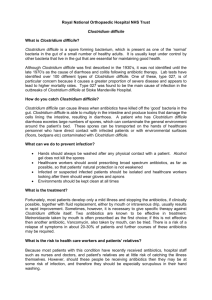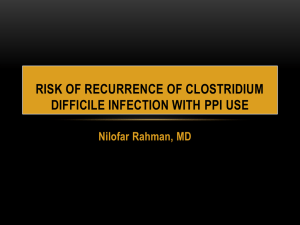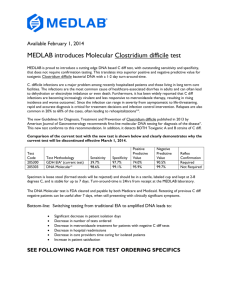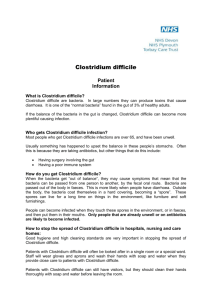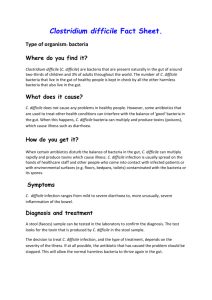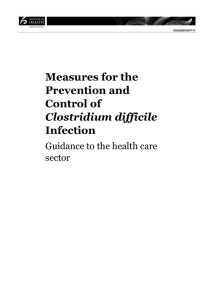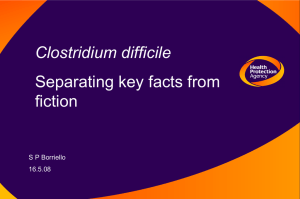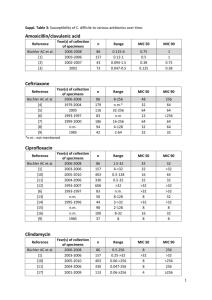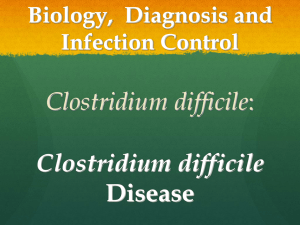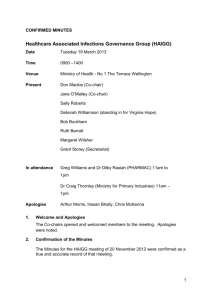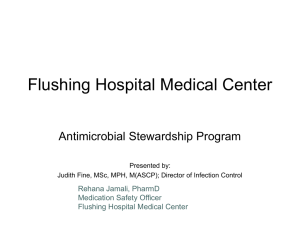Space-Time Relations of C Difficile Cases
advertisement
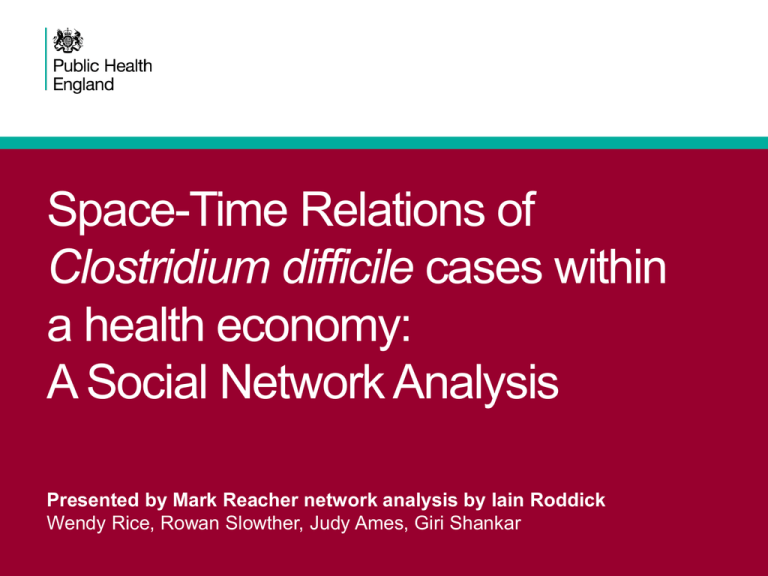
Space-Time Relations of Clostridium difficile cases within a health economy: A Social Network Analysis Presented by Mark Reacher network analysis by Iain Roddick Wendy Rice, Rowan Slowther, Judy Ames, Giri Shankar Clostridium difficile natural history • A common antibiotic associated infectious diarrhoea • Transmission by ingestion of toxin producing spores in faeces of an infected case. • Spores may remain “dormant” in large gut as part of microbiota until ….. • Antibiotic treatment perturbs large gut microflora, spores no longer held in check and proliferate causing Clostridium difficile Associated Disease 2 Space-Time Relations of Clostridium difficile cases within a health economy: A Social Network Analysis Clostridium difficile Associated Disease (CTAD) Comprises a wide range of illness from self limiting diarrhoea to severe protracted diarrhoea, fluid loss , toxic shock, toxic megacolon (requiring life saving colectomy) and acute death. 3 Presentation title - edit in Header and Footer Clostridium difficile control • Universal infection control essential including hand hygiene in care staff : cleaning lavatories and all sanitation surfaces wards and fomites - oxidising disinfectants as well as physical cleaning with detergent required to destroy spores 4 Presentation title - edit in Header and Footer BBC Friday, 5 November, 2004 Hospital superbug must be halved. Bloodstream infections with the hospital superbug MRSA must be halved in three years, the government has said. Health Secretary John Reid tasked NHS hospitals with achieving a year on year reduction up to and beyond March 2008. 5 Presentation title - edit in Header and Footer Development of Health care associated infections Mandatory surveillance 2004 April CDI > 65 years; MRSA bacteraemia 2005 April Enhanced MRSA bacteraemia 2007 April CDI > 2 years 2011 January MSSA and E.coli bacteraemia added 6 Presentation title - edit in Header and Footer Attributing site of acquisition of infection Cases of Clostridium difficile infection occurring within 72 hours of admission have been regarded as acquiring infection prior to admission to that hospital – at another hospital or in the community Hospitals have only been held accountable for infections occurring greater than 72 hours following admission 7 Presentation title - edit in Header and Footer Clostridium difficile reports mandatory surveillance 2007 to 2013 in England 60000 50000 40000 Total 30000 Trust apportioned 20000 10000 0 2007-8 8 2008-9 2009-10 Presentation title - edit in Header and Footer 2010-11 2011-12 2012-13 Examination of space time relations of Community attributed Clostridium difficile cases A substantial proportion of Clostridium difficile cases arising in the North Norfolk health economy were attributed to acquisition in the community Community health services in Norfolk recorded the dates of arrival and discharge in care settings and to home for all new cases of Clostridium difficile infection diagnosed by GP testing in the community over a two year period 9 Presentation title - edit in Header and Footer The Norfolk Community attributed Clostridium difficile cases • 199 county residents who had samples submitted by a GP and tested positive for C.difficile between 2010-2012 • 78 had been admitted at least once to Hospital A • 40 had been admitted at least once to Hospital B • No cases had been admitted to both hospitals • 26 cases had been to Care Homes with at least one other resident case 10 Space-Time Relations of Clostridium difficile cases within a health economy: A Social Network Analysis Social Network Analysis (SNA) • The methods have their roots in the work of 18th Century mathematicians on Graph Theory • Focuses on relationships between individuals rather than their attributes • Applied in a wide variety of scientific research – e.g. genetics, linguistics, electrical engineering, sociology • Advances in computing power and availability of software have made it easier to apply SNA to a wide range of problems outside of formal research 11 Space-Time Relations of Clostridium difficile cases within a health economy: A Social Network Analysis Data & Software • Very simple dataset – Just 5 data fields, captured in Excel: PatientID Location Start Date End Date 1st Positive Specimen Date Procedures written in SQL Server to a) detect space-time coincidences between people in the cohort b) Measure time spent at risk of infection 12 Space-Time Relations of Clostridium difficile cases within a health economy: A Social Network Analysis Co-location of people Hospital A CARE HOME Hospital B C.diffiicile status not considered 85 of 199 people did spend some time together CARE HOME CH …in 2 hospitals, and in 5 care homes B CH + B A CARE HOMES: 13 Space-Time Relations of Clostridium difficile cases within a health economy: A Social Network Analysis Hospital A – Who spent Taking C.difficile time with status who? into consideration – Who wasspecimens Positive at risk? not taken into account Arrow direction represents possiblelines Joining transmission represent co-location for 1 or more Arrow size is indicative of days Number of Days at Risk 14 Space-Time Relations of Clostridium difficile cases within a health economy: A Social Network Analysis CARE HOME Conclusions • Most community diagnosed Clostridium difficile infections had space time overlaps with earlier onset cases at their local hospital •The “72 hour rule” of attributing cases to community acquisition denies the centrality of hospital transmission •Higher levels of infection control are still urgently needed in hospitals to contain the continuing risk of Clostridium difficile 15 Space-Time Relations of Clostridium difficile cases within a health economy: A Social Network Analysis Acknowledgements Alongside my co-authors I’d like to acknowledge the contributions of The Norfolk Health System HCAI Group, and Mr. Steven Martin of Cambridge Institute of Public Health 16 Space-Time Relations of Clostridium difficile cases within a health economy: A Social Network Analysis

